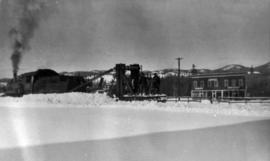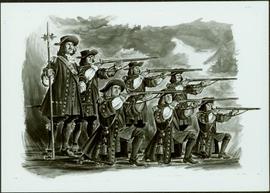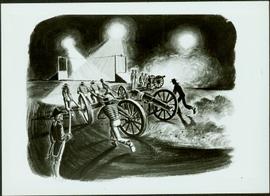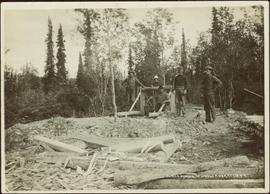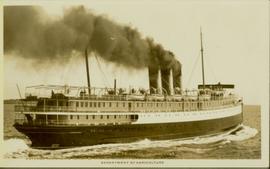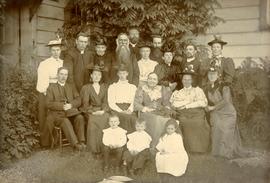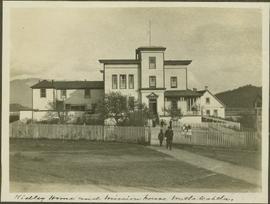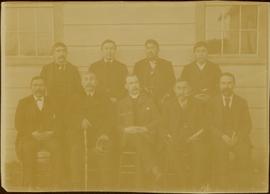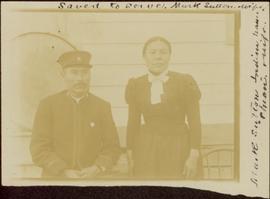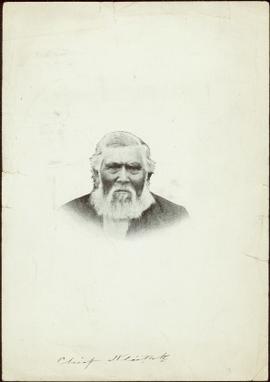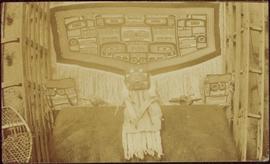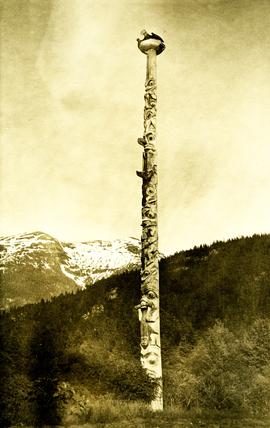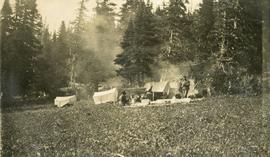Postcard depicts Mt. Field and Kicking Horse River near Yoho National Park.
Postcard depicts the western entrance to Kicking Horse Canyon.
Postcard depicts Kicking Horse Canyon.
Postcard depicts the first crossing from Golden B.C., over the Kicking Horse River.
Postcard depicts the Golden-Field Highway as seen from high up on the mountain side from a tunnel on the CPR run in the Kicking Horse Canyon.
Postcard depicts Stoney Creek Bridge.
Postcard depicts Mt. Bonny near Glacier, BC.
Postcard depicts Glacier House and Great Glacier.
Postcara depoiocts Connaught Tunnel in the Canadian Rockies.
Postcard depicts "The Loop, as this great pear-shaped arc of trestle was known along with the spectacular station and hotel facilities at Glacier were replaced by the Connaught Tunnel in 1916."
Postcard depicts "The Loop," CPR Selkirks.
Postcard depicts "Summit City" in Rogers Pass, built in 1886 and existed only for the consctruction of the CPR.
Postcard depicts the east portal of the Connaught Tunnel.
Postcard possibly taken in Glacier, BC
Postcard depicts Illecillewaet Valley. Circa 1914-16. New grade being built for use with Connaught Tunnel grade reductions at Rogers Pass. Original right-of-way still in use.
Postcard depicts "The Loop," Glacier, BC
Postcard depicts the CPR bridge over the Columbia River.
Postcard depicts Kamloops station at about 1895.
File consists of postcards collected by David Davies of the Thompson and Fraser River Canyons in British Columbia.
Postcard depicts a bridge on the CPR line.
Postcard depicts a reproduction of a photograph from 1880s/1890s. "The Canadian Pacific Railway (C.P.R.) was officially completed to the Pacific Coast in 1885 but upgrading was continually being carried out as seen here near Spence's bridge in 1905."
Postcard depicts Fraser Canyon near North Bend, BC
Postcard depicts Fraser River Canyon, BC
Postcard depicts Yale on the Fraser River.
Postcard depicts Yale, BCin 1881.
Photograph depicts a CNR locomotive pushing snow removal equipment #51070 near a building, possibly a railway station.
Photograph depicts a painting of a battle regiment consisting of six men holding rifles and one man looking on. Typed annotation glued to verso of photograph reads: "Le Régiment de Carignan-Salières - 1665. This famous regiment was dispatched to Canada (then called New France) by King Louis XIV and disembarked from its small sailing vessels on eastern shores in the spring of 1665. Historically it was an important event. Until then, the colonists had been obliged to provide their own defence and the French regiment was the first military protection they enjoyed."; "Le Régiment de Carignan-Salières - 1665. Ce fameux régiment fut envoyé au Canada (appelé alors Nouvelle-France) par Louis XIV. Au printemps de 1665, il débarquait sur les rivages de l'est. Jusque-là, les colons avaient dû se défendre par leurs propres moyens; c'était la première protection militaire qui leur était offerte. L'arrivée des troupes régulières ramenèrent l'espoir aux colons découragés."
Photograph depicts a painting of a naval gun race with men in striped shirts pulling canons and an onlooking officer in uniform. Typed annotation glued to verso of photograph provides an interpretation of this piece of art: "Course de canons de la Marine. Deux équipes, en costumes de la Marine de 1812, réalisent une variante sensationnelle de la course de canons traditionnelle de la Marine. Elles doivent démanteler complètement les canons antiques, les porter en une course d'obstacles difficile et les réassembler pour faire feu. Il faut du courage, du muscle, et des mois d'entraînement."; "Naval gun race. Two teams in naval costumes of 1812 stage a thrilling variation on the traditional naval gun race. They must completely dismantle the antique cannons, carry them over a grueling obstacle course and reassemble the guns for firing. It takes courage, muscle and months of training."
Five unidentified miners pose for a photo. Logs and wood scraps in foreground, forest in background.
Printed annotation on recto of photograph: "PLACER MINING, ATLINTOD RIVER, ATLIN, B.C. A.C. HIRSHFELD NO. 753."
Photograph of the SS "Princess Charlotte" on the open ocean. Metallic annotation on recto reads: "C.P.R.SS Princess Charlotte entered according to act of the parliament of Canada, in the year 1908[?]. by A. Shaw, at the Department of Agriculture." Printed annotation on verso reads "Shaw & Co., Photo. Victoria. B.C. (Empire Series)"
Notebook contains two stories: "The Finding of the Crystals" and "Tit for Tat or The Porcupine and the Beaver". These stories are also found in the Collison manuscript.
Notebook contains Collison's recollections of local history as he heard it, and of the events he encountered during some of his time in ministry.
Group of men, women, and children pose in front of large building.
Handwritten annotation on verso reads: "Metlakatla BC / with Bishop Ridley - 4th from left - back row / Mrs Ridley - 4th from left - front row / [?] - [super?] of Ridley Home (beside the Bishop) / Father Hogan - behind the Bishop".
Photograph depicts an unidentified man walking on path in front of Bishop Ridley's home. Several children can be seen in fenced yard in midground.
Handwritten annotation below image reads: "Ridley Home and Mission house Metlakahtla."; on verso: "Chapter XXVII / Heading for Chapter / Ridley Home Metlakahtla".
Group of eight men wearing suits and ties pose with Reverend Collison (oldest son of Marion & Archdeacon W.H. Collison).
Handwritten annotation on verso reads: “Rev. W. E. Collison & his Lay Readers at Massett, Q.C.Is.”
Chief Allen sits in chair on raised wooden platform, with bear skin over his knee, and two more bear skins laid on wood blocks in front of him. House stands behind picket fence in background. Pot and pan sit to right of chair in foreground.
Handwritten annotation on verso reads: "Albert Allen Kincolith (Nisga Chief)".
Mark Sutton, in Christian Army uniform, is seated while his wife stands next to him. A drum is visible in the background.
Handwritten annotation in pen on recto reads: “Saved to serve. Mark Sutton & wife. Mark Sutton Indian name ‘Chean’ (?) & wife.” Handwritten annotation in pen on verso reads: “Chapter VI. No. 1. Mark Sutton & wife. Only survivor of crew of canoe shot by war party. Twice doomed but “Saved to Serve.”
Photograph features a portrait of an elder taken from the neck up. Handwritten annotation on recto, along bottom of photo reads: “Chief Stlaituk”(?)
Photograph features an arranged collection of Chief’s ceremonial regalia: Chikat robe and Amalayt (headdress), two carved wooden rattles and two leggings.
Handwritten annotation in pen on recto reads: “Qush ahlied (?) or Chilcat [sic] Robe worn by Chiefs when entertaining. Also 'Ahm Ahlied'(?) or Head Ornament Indian Coronet and leggings." Verso also has additional handwritten annotations which have been crossed out.
Totem pole stands alone against a mountainous background.
Postcard depicts the CNR and CPR crossings in the Fraser Canyon.
Postcard depicts Hells Gate, Fraser Canyon, BC
Postcard depicts CPR and CNR bridges at Cisco-Fraser River, Canyon, BC
Postcard depicts a CPR train labelled "Kamloops" in Yale, BC
Postcard depicts a "massive 4-4-0 wood burning locomotive ready to enter the turn table from the round house. These CPR locomotives were in common use from 1886 until 1915, running from the Kootenays through the Fraser Canyon."
Postcard depicts Fraser Canyon in the Rocky Mountains of western Canada.
Postcard depicts the Four Tunnels in Fraser River Canyon, BC
Postcard depicts the tunnels of the Fraser Canyon, Rocky Mountains, BC
Photograph depicts a cluster of tents on the edge of a meadow. Four or more people stand or sit amongst the tents. Smoke rises from a wood fire and drifts amongst the stub alpine trees in the background.
